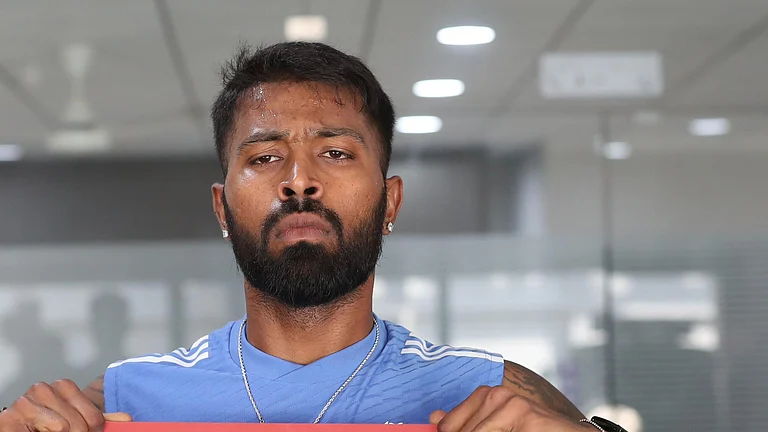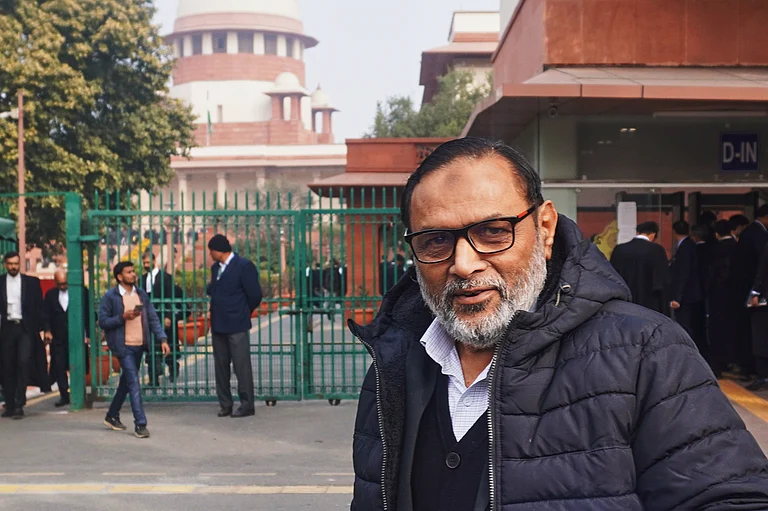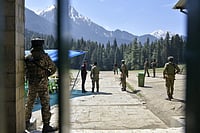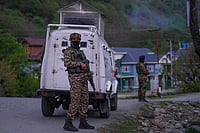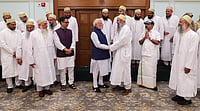Manju Gosai’s wedding to her friend and classmate Swapnil Gadag last December was a dreamy affair. The fairytale wedding took place in the coastal town of Boisar in Palghar, near Mumbai.
The 30-year-old Garhwali native ditched the trademark red lehenga and draped herself in a breezy Maharashtrian nine-yard Nauwari saree for the inter-faith wedding ceremony. She appeared on the mandap in the traditional regalia, complete with the pearl-encrusted nath (nose ring) and stood behind the white cloth partition separating her and the groom. The unique Warli wedding in Dhavleri style commenced with three elderly women singing in unison. The women are widows—known as Dhavleri—and are called upon to ordain weddings as per the customs of the Adivasi Warli tribe to which the groom belongs.
The Warli tribe, which lives in the Palghar and Thane districts on Maharashtra’s border with Gujarat, consider Dhavleri widows auspicious and bestows on them the honour of performing weddings, unlike the Hindu majority that, in many cases, ostracises and casts out widows from joyous occasions. The Dhavleris sing a 35-minute-long wedding song in the Warli dialect, inviting all the forces of nature—the sun, the moon, air, rivers, forests, and their wives and children—to bless the couple. At the end of the song, the bride and the groom garland each other and they are declared to be married.
“My biggest worry was standing still behind the antarpath—the cloth that is held as a partition—for over 40 minutes and not fainting. But luckily it got over quickly,” Gosai said. Her side of the family was amazed by the novelty of the wedding and whipped out their phones to film the special ceremony.
“In Garhwali communities, marriage is conducted by the hands of Brahmin priests only, so the Dhavleri custom was unique, and I wanted to respect and embrace the culture of my new Warli family. It was an honour for me to get married at the hands of Dhavleri,” Gosai said, adding that her family readily accepted the Dhavleri tradition after her husband explained the concept.

Gadag, 30, said it was important for him to have Dhavleris preside over the ceremony as the Warli culture is increasingly endangered due to the rampant religious conversion to Hinduism and Christianity. “It is the custom of my tribe under which my parents and before that, my grandparents and ancestors, got married. I am proud of our Adivasi culture and wanted to set an example for the community to embrace our traditions and heritage.”
Poverty, hunger, and malnutrition are a common bane in Palghar district, home to a large population of tribes from the Warli, Kokana, Kunbi, and Mahadev Koli communities. “Many families are converting and Warlis are now worshipping Hindu Gods and Jesus. It is wiping out our culture. The weddings are held in Hindu and Christian style, there are no signs of indigenous tradition like the wedding chowk,” he said.

The Warlis draw the traditional stick-figure paintings outside the house of the groom and the bride, announcing the wedding. The mural drawn on a red earth background with a white rice paste, depicts the life span of humans, the natural surroundings, trees, birds, and nature Gods. Hailing from a prominent Warli family in Dahanu, Gadag has a vast network of friends and relatives in the medical, political, and administrative services. He wanted to set an example by having a Dhavleri-style wedding as a message to the community to preserve the Warli culture.
The Gosai-Gadag wedding became a reality thanks to Kirti Vartha, a social activist and a member of the Warli community, who is mobilising widows from the Warli tribe. She has brought together 91 widows from Dahanu, Palghar, and Vikramgadh districts through her NGO—The Dhavleri Group. In the past two years, Vartha has helped conduct 200 mass public weddings and around 40 individual weddings in Dhavleri style. A group of three widows conducts the ceremony for three days and charges Rs 3,000.
“Traditionally, a Warli wedding would be conducted only by Dhavleri. It was mandatory for us to have their presence. The custom is unique in our community as widows are respected and invited to invoke our gods. But this tradition is fast depleting, our people have forgotten it,” she says, adding that many Warli people get converted for free ration and medical care and stop following indigenous culture.
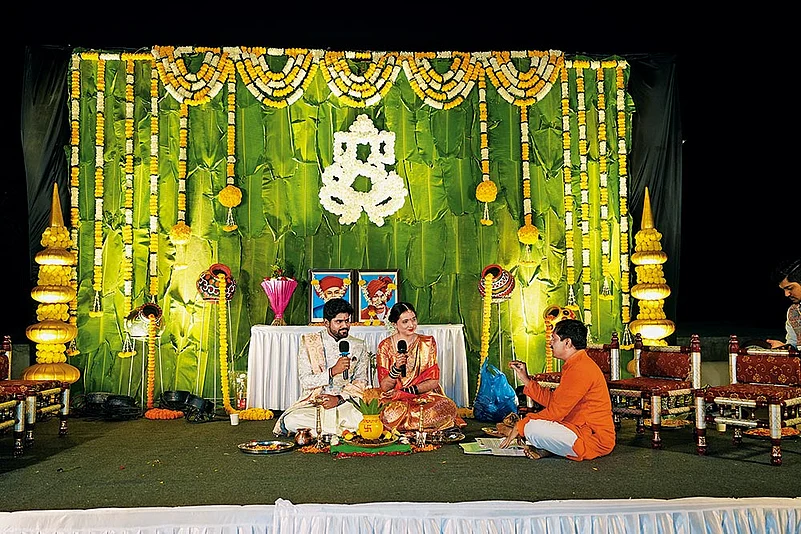
To revive the tradition, Vartha began holding public awareness meetings in the villages and coaxing elderly tribals to get their children married under the Dhavleri style. “Dhavleris have deep traditional knowledge. They have songs for every wedding ritual and all occasions, from birth to death. If we do not practice this wedding tradition, the songs will disappear and our future generations will not know about the unique traditions. If our traditions survive, we will survive.”
Viraj Gadag, a cousin of Swapnil, said more people needed to be aware of the tribal customs which are influenced by Paganism and nature worship. “People are more accepting of the majority Hindu culture and traditions as they don’t know of their own right traditions. Our gods and rituals are different from the Hindu religion. We worship Waghoba (tiger) dev and Hirva (green nature) dev, crops and grains. These are simple customs but full of meaning and life and changing seasons. But our society is increasingly falling under the influence of alcoholism, Brahmin traditions and Bollywood songs.”
While the trend of lavish five-day weddings, with sangeet, haldi and cocktail parties, largely made popular by the Hindi film industry and television in Mumbai, has become common across the country, Vartha and Gadag are going back to the roots, reviving the lapsed traditions. The progressive state of Maharashtra has various other communities that believe in celebrating weddings with austerity while honouring the social and political ideology. These weddings involve no religious ceremonies, Brahmin priests, or dowries.
The Warli tribe, which lives in Palghar and Thane, considers Dhavleri widows auspicious and bestows on them the honour of performing weddings.
Adinath Chavan, the editor of Agrowon newspaper, was keen to set precedent for his family towards the progressive ideology of anti-casteism. For the wedding of his son Nishant, Chavan decided to conduct the ceremony in the Satyashodhak way, started by social reformer Jyotiba Phule.
To fight against upper caste hegemony and Brahmin dominance, Phule started the Satyashodhak (truth seekers) Society in 1873 and popularised simple weddings with no priest or Sanskrit rituals as a rebuke to Brahmin customs. “I wanted to revive Phule’s tradition and do away with the oppressive practices that keep us regressed. The Satyashodhak way is old, but somewhere there has been a break in this tradition. I explained my reasons and ideas to my son and daughter-in-law and they liked it,” Chavan said.
For the wedding held on February 18 in Kolhapur, the family did not select a muhurat and agreed on a convenient time in the evening for the guests to attend. There were no religious rituals or priests. The stage included photos of Phule and social reformer Shahu Maharaj of Kolhapur. In a ceremony lasting 45 minutes, the bride and groom did pooja of the elderly members of the family, worshipped the five elements and took the blessings of the family. “We also planted flowers and tulsi saplings. The entire ceremony was ecofriendly and there were no firecrackers. We were happy to be part of an exemplary wedding,” bride Rajnandini Desai said.
In the drought-prevalent Western Maharashtra region, where many face an agrarian crisis and poverty, dowries and large weddings with a feast for thousands of villagers are common practices. Usually, all the wedding expenses fall on the bride’s family who are forced to borrow large sums of money from private lenders. Chavan and Desai’s Satyashodhak wedding had no dowry or gifts from guests.
In Latur, businessman Pravin Kadam, 32, and lecturer Akshata Mane, 28, got married on February 11 in a similar wedding but in Buddhist ceremony. The portrayal of the wedding in an episode of web series Made in Heaven featuring actor Radhika Apte was lauded for mainstreaming Dalit culture. But in the Marathwada region, Buddhist weddings are prevalent among the Bahujan communities.
“We wanted a simple wedding, in keeping with our traditions. There were no two thoughts on doing it this way,” Mane said. The ceremony was conducted by a Buddhist priest called Bhante and the bride and groom were dressed in pristine white. The wedding stage included a golden statue of Gautam Buddha and a statue of Dr Babasaheb Ambedkar.
“Bhante recited Vandana in the ancient Pali language, and we prayed to Buddha and Ambedkar. We took a pledge to be loyal to each other as husband and wife. The ceremony was conducted in half an hour,” Kadam recalled.
MORE FROM THIS ISSUE
The “simple” wedding was attended by 2,000 guests from both the bride and groom’s sides. “In our region, weddings include rigid rituals that are unavoidable and bring a lot of stress financially. Whatever you do or however lavishly you spend, it always falls short. We were happy to do the Buddhist weddings with no such pressure, out of our own happiness,” Kadam said.








